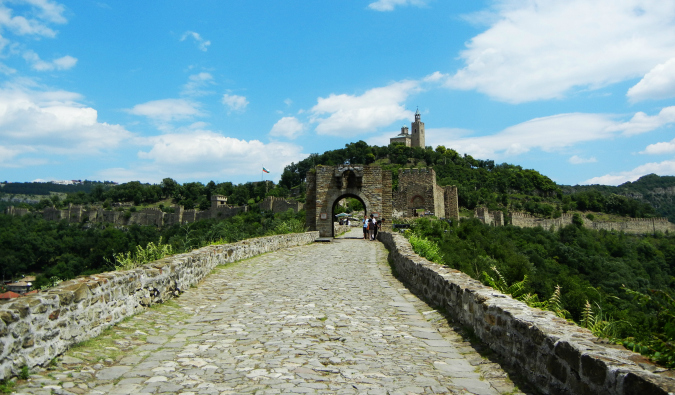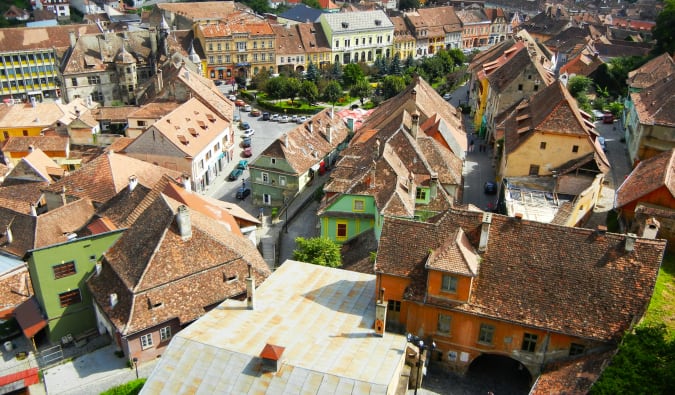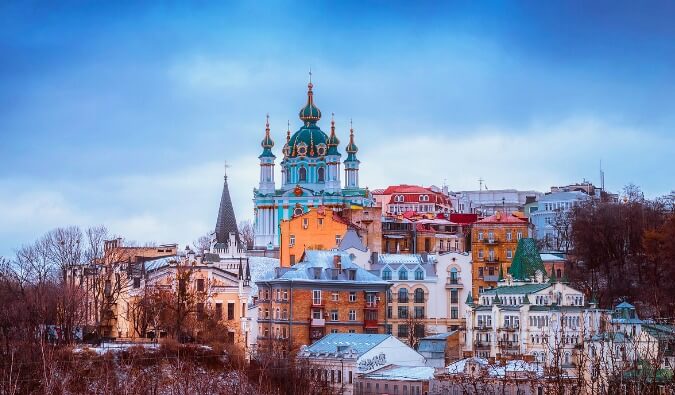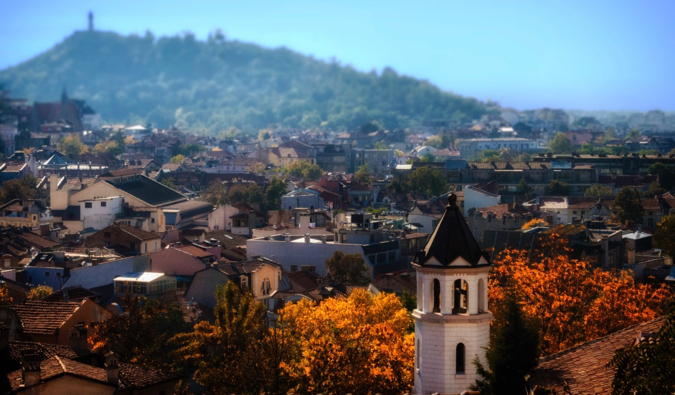
Last Updated: 1/31/23 | January 31st, 2023
When most people visit Europe they have a tendency to stick to the western and central regions of the continent. England, Spain, France, Germany, and Italy all see their fair share of tourists — and then some!
Travelers with a longer trip in mind will branch out a little more, maybe visiting the Czech Republic, Austria, or the stunning coastline of Croatia for some fun in the sun.
But few tourists head to far Eastern Europe.
I’m talking about Bulgaria, Romania, and Ukraine. While Bulgaria sees a few more tourists because of its proximity to the Balkans and acts as a stop on the overland route from Turkey to Budapest, the farther north I went, the fewer travelers I saw.
In Ukraine, I only encountered US Peace Corps volunteers and a handful of Europeans. (Obviously, this was before the ongoing conflict).
I don’t understand why — with the current exception of Ukraine (due to the Russian invasion), these countries are inexpensive and safe, and they lack the overwhelming crowds you find elsewhere in Europe.
Plus, if you want to pay less for awesome quality meals that would be pricey in other places, this is the place to be. In Varna, Bulgaria, for example, you can eat delicious seafood on the coast at a fraction of the price you’d pay in Italy. And it’s just as delicious.
These countries are generally around half the price of their Western counterparts. In fact, during my 46 days in these three countries, I spent a total of $1,876.50 USD. And that was even taking into account all the sushi I splurged on! That’s a great deal for 46 days in Europe.
While I would normally break down the cost of each country into a single post, I want to put these countries together so you can see all at once how affordable this area of Europe is.
Table of Contents
The Cost of Bulgaria
While in Bulgaria, I spent a total of 1,405 BGL in 23 days. That worked out to be roughly $1,000 USD, or $44 USD per day at today’s exchange rate. In the 23 days I was there, I visited all the major sightseeing destinations, including the expensive and overrated Sunny Beach.
How I Spent My Money:
- Food: 475.90 BGL (cheap local meals, a few restaurants, and a lot of sushi)
- Accommodation: 445.70 BGL (I stayed in dorm rooms and couchsurfed for five nights)
- Alcohol: 259.40 BGL (I partied pretty heavily, especially along the Black Sea)
- Buses: 100 BGL
- Taxis: 19 BGL (a few intra-city and airport taxis.)
- Tours/Sightseeing: 53 BGL
- Movies: 42.05 BGL
- Water: 8.90 BGL
- Chess in the park: 1 BGL
How Much Can You REALLY Do It For?
About the same. Excluding my sushi splurge, my daily average would have been around $38.29 USD. I didn’t spend lavishly in Bulgaria or really do anything beyond what the normal budget traveler would do. I used local transport, ate local meals, and stayed in cheap hostels. If you aren’t a sushi fan, budgeting $35–40 USD per day in Bulgaria should be adequate (slightly less if you cut out alcohol and aren’t partying).
If you’re looking for nicer accommodations and more restaurant meals, you should consider budgeting $50–55 USD per day. And if you want to stay in hotels and have a much more “mid-range” trip (instead of a budget trip), you can do that for as little as $75 USD per day.
And while these are not the rock-bottom prices you can find in other parts of the world, when comparing them to prices in Western Europe or Scandinavia, things are considerably cheaper.
How to Save Money in Bulgaria
While Bulgaria is very affordable, there are lots of ways to save even more money. Here are my best money-saving tips to help you keep costs low in Bulgaria:
1. Stay with a local – Hostels are cheap, but if you want to save even more money on accommodation, you can Couchsurf and stay with locals for free. It’s the best way to save on accommodation while connecting with a local guide who can share their insider tips and advice.
2. Cook your own meals – While eating out here is cheap, it’s even cheaper to shop at grocery stores and cook your own meals. The markets have a wide variety of inexpensive fruits and vegetables. If you plan on cooking your own food, groceries will cost around 45-70 BGN per week for basic necessities like pasta, vegetables, chicken, and other basic foodstuffs.
3. Stay at Hostel Mostel – Staying at Hostel Mostel can lower your costs because it’s usually the cheapest hostel available. They also offer discounts if you stay over 3 nights. They have locations in Sofia and Velinko Tarnovo.
4. Take buses – The trains in Bulgaria are more expensive than buses. Use Sofia as your main hub for traveling via bus as you can get anywhere in the country from here quite easily. A bus ride from Sofia to Varna is 33 BGN, to Plovdiv is 15 BGN, and Veliko Tarnovo is 23.50 BGN. Stick to buses if you’re on a budget!
5. Avoid Sunny Beach – I’ll be honest: I don’t understand the appeal of a beach that’s both expensive and crowded with tourists. There are more beach chairs here than sand and it is way overpriced. Unless you’re looking to binge drink and party, skip Sunny Beach. If you want a more chill beach vibe with smaller beach bars and restaurants, try Varna or Burgas instead.
6. Travel in the off-season – June-September is the peak summer season in Bulgaria so you’ll see a larger influx of tourists then and prices will be slightly higher. Winters are an ideal time for Bulgarian budget travel when you can enjoy less-crowded destinations, plenty of scenic beauty, and good opportunities for skiing in the snow (just avoid Christmas as prices jump up).
7. Eat at the bakeries – Bakeries in Bulgaria have a delicious and affordable range of pastries and foods which will fill you up in the morning. Head to the bakery for cheap snacks and tasty treats.
8. Bring a water bottle – The tap water here is safe to drink so bring a reusable water bottle to save money and reduce your plastic use. LifeStraw is my go-to brand as their bottles have built-in filters to ensure your water is always clean and safe.
9. Take free walking tours – Walking tours are a great way to get familiar with a city and its culture. Sofia, Veliko Tarnovo, and Plovdiv all have free walking tours that cover all the highlights of each city. Just be sure to tip your tour guide at the end.
The Cost of Romania
Romania has been growing in popularity over the years, but is still relatively untouched. While here, I spent 1878.30 RON over 16 days. That works out to be 117.38 RON ($36 USD) per day. This covered the cost of travel from Bucharest through Brasov and Transylvania to Cluj-Napoca.
How I Spent My Money
- Food: 724.4 RON (sushi meals, a few nice restaurants, as well as cooking for three days)
- Accommodation: 881 RON (dorm rooms and two nights in a private room)
- Alcohol: 9 RON
- Transportation: 113.9 RON (buses and airport taxis)
- Tours/Sightseeing: 80 RON (Bran Castle, a bunch of museums, and walking tours)
- Cold Medicine: 57 RON
- Water: 13 RON
How Much Can You REALLY Do It For?
These days, as prices have risen, it is possible to do it for cheaper — but you’ll need to cut back. Most backpackers should aim for around 140 RON per day ($31 USD), though you’ll probably spend more if you drink. This budget assumes you’re staying in hostels, taking public transportation, doing mostly free activities, cooking most of your meals, and limiting your drinking.
If you want a few nights in a private room, nicer meals, and more activities, your budget will be around 265 RON or $58 USD. As you can see, it’s very easy to travel here on a budget without missing out!
How to Save Money in Romania
I didn’t find that Romania offered amazing ways to save. There wasn’t really any single thing that I found and was like, “Wow! This is going to be great! My budget is saved!” Outside the normal Couchsurf/cook/eat local tips that I mention above. However, there are a few things you can do to save a couple of bucks:
1. Use rideshares – One helpful app you’ll want to check out is BlaBlaCar. It’s a ride-sharing app that is quite popular in Romania (and all over Europe). It’s not necessarily cheaper than buses or trains but it is usually faster and is a more unique experience. You can also use it to visit neighboring countries as well.
You simply download the app, look for drivers going to where you’re heading, and request a ride. Drivers have reviews as well so it’s very similar to Airbnb in that regard. Once approved, you pay a small fee and then you’re all set.
Just keep in mind that many drivers don’t post their trips until a day or two before. But if you’re flexible, this can be a great option.
2. Hitchhike – Hitchhiking is quite common (and relatively safe) in Romania. If you’re an intrepid backpacker and don’t mind thumbing it, definitely give it a try! (Just be sure to use common sense, take precautions, and trust your gut!). For tips and advice, check out Hitchwiki.
3. Shop at discount grocery stores – If you’re going to cook (or are just grabbing a snack), you can save money by shopping at discount supermarkets. These include Profi, Lidl, and Penny Market.
4. Stay at Balkan Backpacker Hostels – Balkan Backpackers have hostels all around Romania and the Balkans that are a part of the same hostel network. If you book directly with these and download their app you’ll get 10% off your stay.
The Cost of Ukraine
My last stop in the region was Ukraine. Unfortunately, as of the time of this writing in 2023, the war in Ukraine continues. Due to safety reasons, it’s not possible to travel there at the moment. Hopefully, this will again be possible in the future.
While I was in Ukraine, I spent a total of 2377.95 UAH ($297 USD at the time) in the seven days I visited the country. That works out to be a 339.70 UAH per day ($43 USD at the time). I was in Kyiv and Lviv while I was there.
How I Spent My Money
- Accommodation: 740 UAH (I stayed in dorm rooms for about 100–110 UAH per night)
- Food: 1122.50 UAH (mostly local Ukrainian restaurants and two fancy sushi dinners)
- Alcohol: 261 UAH (two nights out in Kyiv)
- Transportation: 219.20 UAH
- Tours/Sightseeing: 10 UAH
- Water: 15.25 UAH
- Chess: 10 UAH (I paid to lose at chess in the park. It was fun.)
How Much Can You REALLY Do It For?
One of the reasons my budget for Ukraine was so high was because I went out for sushi twice. When you exclude those meals from my budget, my daily average drops to 251 UAH or $31 USD. I don’t think you can visit Ukraine for much cheaper than that. I was the ultimate backpacker here and stuck to everything cheap.
However, I suggest you spend more and not be so frugal. Splurge on sushi or drinks or a nice room every so often. This country is cheap (the cheapest I’ve been to in Europe, in fact). When it becomes possible to visit again I’m sure they will appreciate the tourism. It’s a good place to live it up. Ukraine is currently one of the best value countries in Europe. Make the most of it while you can.
How to Save Money in Ukraine
If you really feel the need to spend even less money in Ukraine, you can do three things:
1. Stay with a local – If 140-280 UAH per night is too much for you, then Couchsurf and save yourself money. It’s the best way to connect with locals and get insider tips.
2. Head out of Kyiv – The country is substantially cheaper outside of Kyiv, as well as the closer you get to Russia.
3. Eat local – By only eating at local restaurants like Puzata Khata, you’ll keep your food prices down as low as you can. You can also cut out eating at restaurants altogether and cook your meals for even greater savings.
4. Book overnight trains – Take advantage of the slow and cheap trains in Ukraine by taking overnight trains. You save one night’s accommodation by doing this.
5. Buy beer at the supermarkets – If you plan on drinking, buy your beer at the supermarket. Beer at the bar is cheap, but this is even cheaper!
A Final Note
Alcohol. It’s big in Eastern Europe — and it’s cheap. In all these countries, you can buy beer in supermarkets and corner shops for just a couple of bucks. It’s incredibly good value and is the way to party on the cheap. Stick to buying your own alcohol instead of drinking at restaurants and bars. While the difference might not seem big, over the course of a few weeks that money will add up. If you’re on a budget, stick to buying your alcohol in stores instead of restaurants and bars.
Eastern Europe is the best bargain you’ll find on the continent. These three countries were much more affordable than I’d previously thought, and traveling here definitely helped me correct some of the overspending and higher costs of Western Europe. And while the war in Ukraine has put a damper on the region, it’s perfectly safe to visit Eastern Europe as long as you avoid Ukraine and cities directly near the border.
Beyond just the monetary savings here, these countries are rich in history and delicious food, and they offer a challenge for travelers that you don’t find on the well-worn trail in other parts of Europe. I’m so happy to have finally made it out here.
Note: Poland, the Balkans, and the Baltic states also all offer amazing value as well. Don’t miss them if you’re exploring Eastern Europe! I didn’t visit Moldova because of time constraints, but I’ve heard its prices are on par with the rest of the area. I didn’t go to Belarus either because it costs a few hundred dollars for a visa and I didn’t feel I would spend enough time there to justify the cost. I’ll save those countries for another trip!
Get Your In-Depth Budget Guide to Europe!
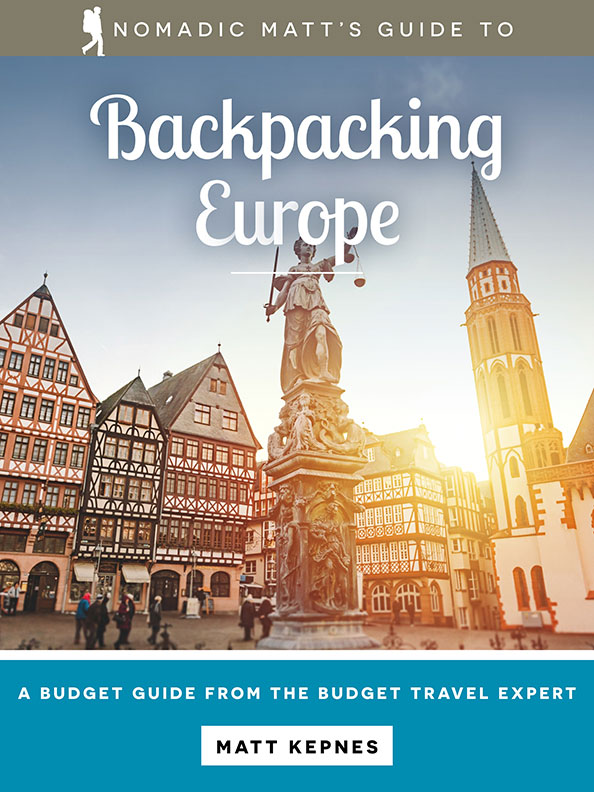
My detailed 200+ page guidebook is made for budget travelers like you! It cuts out the fluff found in other guides and gets straight to the practical information you need to travel while in Europe. It has suggested itineraries, budgets, ways to save money, on and off the beaten path things to see and do, non-touristy restaurants, markets, bars, safety tips, and much more! Click here to learn more and get your copy today.
Book Your Trip to Europe: Logistical Tips and Tricks
Book Your Flight
Use Skyscanner to find a cheap flight. They are my favorite search engine because they search websites and airlines around the globe so you always know no stone is left unturned.
Book Your Accommodation
You can book your hostel with Hostelworld as they have the biggest inventory and best deals. If you want to stay somewhere other than a hostel, use Booking.com as they consistently return the cheapest rates for guesthouses and cheap hotels. Here are my favorite hostels in Europe.
Don’t Forget Travel Insurance
Travel insurance will protect you against illness, injury, theft, and cancellations. It’s comprehensive protection in case anything goes wrong. I never go on a trip without it as I’ve had to use it many times in the past. My favorite companies that offer the best service and value are:
- Safety Wing (best for everyone)
- Insure My Trip (for those over 70)
- Medjet (for additional evacuation coverage)
Looking for the Best Companies to Save Money With?
Check out my resource page for the best companies to use when you travel. I list all the ones I use to save money when I’m on the road. They will save you money when you travel too.
Looking for more information on visiting Europe?
Be sure to visit our eobust destination guide to Europe for even more planning tips!
